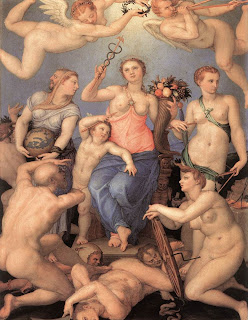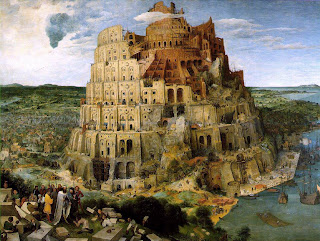| Birth name | Pieter Bruegel |
| Born | c. 1525, Breda, Habsburg Netherlands |
| Died | September 9, 1569 (age 44), Brussels, Habsburg Netherlands |
| Field | Painting, printmaking |
| Movement | Dutch and Flemish Renaissance |
| Works | The Peasant Wedding |
Pieter Bruegel the Elder (c. 1525 – 9 September 1569) was a Netherlandish Renaissance painter and printmaker known for his landscapes and peasant scenes (Genre Painting). He is sometimes referred to as "Peasant Bruegel" to distinguish him from other members of the Brueghel dynasty, but is also the one generally meant when the context does not make clear which "Bruegel" is being referred to. From 1559 he dropped the 'h' from his name and started signing his paintings as Bruegel.
Life
There are records that he was born in Breda, Netherlands, but it is uncertain whether the Dutch town of Breda or the Belgian town of Bree, called Breda in Latin, is meant. He was an apprentice of Pieter Coecke van Aelst, whose daughter Mayken he later married. He spent some time in France and Italy, and then went to Antwerp, where in 1551 he was accepted as a master in the painter's guild. He traveled to Italy soon after, and then returned to Antwerp before settling in Brussels permanently 10 years later. He received the nickname 'Peasant Bruegel' or 'Bruegel the Peasant' for his alleged practice of dressing up like a peasant in order to mingle at weddings and other celebrations, thereby gaining inspiration and authentic details for his genre paintings. He died in Brussels on 9 September 1569 and was buried in the Kapellekerk. He was the father of Pieter Brueghel the Younger and Jan Brueghel the Elder. Both became painters, but as they were very young children when their father died, it is believed neither received any training from him. According to Carel van Mander, it is likely that they were instructed by their grandmother Mayken Verhulst van Aelst, who was also an artist.
Style
In Bruegel's later years he painted in a simpler style than the Italianate art that prevailed in his time. The most obvious influence on his art is the older Dutch master Hieronymus Bosch, particularly in Bruegel's early "demonological" paintings such as The Triumph of Death and Dulle Griet (Mad Meg). It was in nature, however, that he found his greatest inspiration as he is identified as being a master of landscapes. It was in these landscapes that Bruegel created a story, seeming to combine several scenes in one painting. Such works can be seen in The Fall of the Rebel Angels and the previously mentioned The Triumph of Death.
Themes
Bruegel specialized in genre paintings populated by peasants, often with a large landscape element, but also painted religious works. Making the life and manners of peasants the main focus of a work was rare in painting in Brueghel's time, and he was a pioneer of the Netherlandish genre painting. His earthy, unsentimental but vivid depiction of the rituals of village life—including agriculture, hunts, meals, festivals, dances, and games—are unique windows on a vanished folk culture and a prime source of iconographic evidence about both physical and social aspects of 16th century life. For example, the painting Netherlandish Proverbs illustrates dozens of then-contemporary aphorisms (many of them still in use in current Dutch or Flemish), and Children's Games shows the variety of amusements enjoyed by young people. His winter landscapes of 1565 (e.g. Hunters in the Snow) are taken as corroborative evidence of the severity of winters during the Little Ice Age.
Using abundant spirit and comic power, he created some of the early images of acute social protest in art history. Examples include paintings such as The Fight Between Carnival and Lent (a satire of the conflicts of the Reformation)[citation needed] and engravings like The Ass in the School and Strongboxes Battling Piggybanks. On his deathbed he reportedly ordered his wife to burn the most subversive of his drawings to protect his family from political persecution.
References in other works
Bruegel's work plays prominently in Don DeLillo's 1997 novel Underworld (DeLillo novel). In the prologue, titled "The Triumph of Death" and set at the 1951 baseball game between the Giants and the Dodgers in which Bobby Thomson hit the so-called "Shot Heard 'Round the World", a reproduction of the eponymous painting (c. 1562) floats down into J. Edgar Hoover's hands amidst a celebratory hailstorm of loose bits of paper and other pieces of trash after the home run. Later in the novel, the concepts of death and play (activity) are compared with one another as the character Albert Bronzini discusses another Bruegel painting, Children's Games (1560): "I don't know what art history says about this painting. But I say it's not that different from the other famous Bruegel, armies of death marching across the landscape. The children are fat, backward, a little sinister to me. It's some kind of menace, some folly. Kinderspielen. They look like dwarves doing something awful" (U 682).
Works
There are about 45 authenticated surviving paintings, one-third of which are in the Kunsthistorisches Museum in Vienna. A number of others are known to have been lost. There are a large number of drawings. Brueghel only etched one plate himself, The Rabbit Hunt, but designed many engravings and etchings, mostly for the Cock publishing house.
Naval Battle in the Gulf of Naples, 1560, Galleria Doria-Pamphilj, Rome
The Fall of the Rebel Angels, 1562, Royal Museums of Fine Arts of Belgium, Brussels
The "Little" Tower of Babel, c. 1563, Museum Boymans-van Beuningen, Rotterdam
The Procession to Calvary, 1564, Kunsthistorisches Museum, Vienna
The Adoration of the Kings, 1564, The National Gallery, London
Massacre of the Innocents, c. 1567, versions Royal Collection, Kunsthistorisches Museum, Vienna, and London art market (2007)
Winter Landscape with a Bird Trap, 1565, Royal Museums of Fine Arts of Belgium, Brussels, inv. 8724
Landscape with Christ and the Apostles at the Sea of Tiberias, 1553, probably with Maarten de Vos, private collection
Ass at School, 1556, drawing, Print room, Berlin State Museums
Parable of the Sower, 1557, Timken Museum of Art, San Diego
Landscape with the Fall of Icarus, c.1554-55, Royal Museums of Fine Arts of Belgium, Brussels - Note: Now seen as a copy of a lost authentic Bruegel painting[2]
Netherlandish Proverbs, 1559, - Gemäldegalerie, Berlin
The Fight Between Carnival and Lent, 1559, Kunsthistorisches Museum, Vienna
Portrait of an Old Woman, 1560, Alte Pinakothek, Munich
Children's Games, 1560, Kunsthistorisches Museum, Vienna
Temperance, 1560
Saul (Battle Against The Philistines On The Gilboa), 1562, Kunsthistorisches Museum, Vienna
Two Small Monkeys, 1562, Staatliche Museen, Gemäldegalerie, Berlin
The Triumph of Death, c. 1562, Museo del Prado, Madrid
Dulle Griet (Mad Meg), c. 1562, Museum Mayer van den Bergh, Antwerp
The Tower of Babel, 1563, Kunsthistorisches Museum, Vienna
Flight To Egypt, 1563, Courtauld Institute Galleries, London
The Death of the Virgin, 1564, Upton House, Banbury, Oxfordshire, UK
The Months. A cycle of probably 6 paintings of the months or seasons, of which five remain:
The Hunters in the Snow (Dec.-Jan.), 1565, Kunsthistorisches Museum, Vienna
The Gloomy Day (Feb.-Ma.), 1565, Kunsthistorisches Museum, Vienna
The Hay Harvest (June-July), 1565, Lobkowicz Palace at the Prague Castle Complex, Czech Republic
The Harvesters (Aug.-Sept.), 1565, Metropolitan Museum of Art, New York
The Return of the Herd (Oct.-Nov.), 1565, Kunsthistorisches Museum, Vienna
Christ and the Woman Taken in Adultery (1565), Courtauld Institute of Art, London
The Calumny of Apelles, 1565, drawing, British Museum, London
The Painter and the Connoisseur, drawing, c. 1565, Albertina, Vienna
Preaching Of John The Baptist, 1566, Museum of Fine Arts (Budapest)
Census at Bethlehem, 1566, Royal Museums of Fine Arts of Belgium, Brussels
The Wedding Dance, c. 1566, Detroit Institute of Arts, Detroit
Conversion Of Paul, 1567, Kunsthistorishes Museum, Vienna
The Land of Cockaigne, 1567, Alte Pinakothek, Munich
The Magpie on the Gallows, 1568, Hessisches Landesmuseum, Darmstadt
The Misanthrope, 1568, Museo di Capodimonte, Naples
The Blind Leading the Blind, 1568, Museo Nazionale di Capodimonte, Naples
The Peasant Wedding, 1568, Kunsthistorisches Museum, Vienna
The Peasant Dance, 1568, Kunsthistorisches Museum, Vienna
The Beggars, 1568, Louvre, Paris
The Peasant and the Nest Robber, 1568, Kunsthistorisches Museum, Vienna
The Three Soldiers, 1568, The Frick Collection, New York City
The Storm at Sea, an unfinished work, probably Bruegel's last painting.
Prints
Large Fish Eat Small Fish, 1556, a print after a Bruegel design
http://en.wikipedia.org/wiki/Pieter_Bruegel_the_Elder



